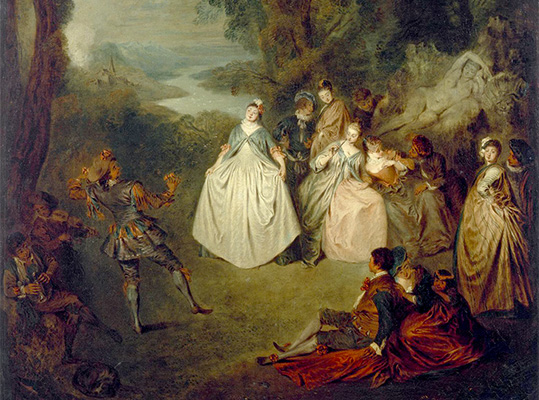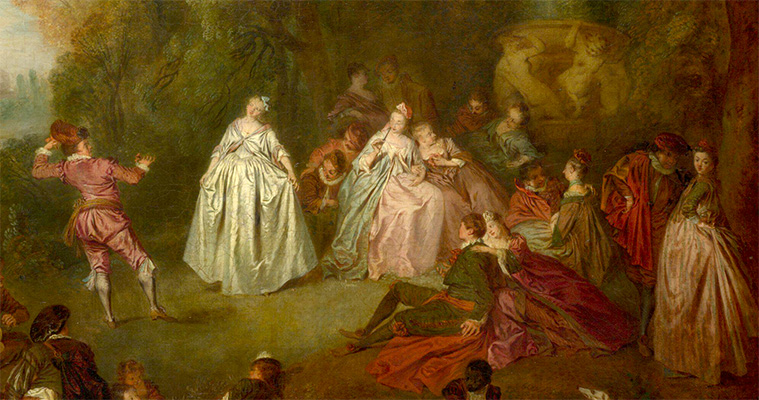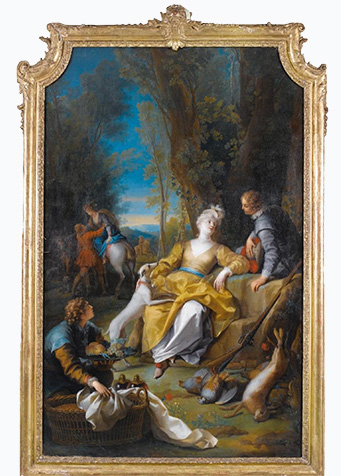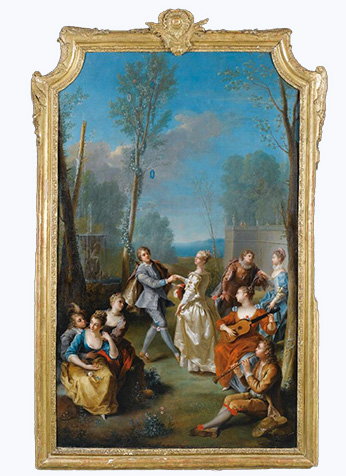
- Home Page
- Accepted
Paintings & Copies - Doubtful
Attributions - Doubtful Textual References
- Alternative
Titles - Collectors &
Museums - Bibliography
- Search Abecedario
- Watteau &
His Circle
X. Scenes in a Garden
Entered May 2022
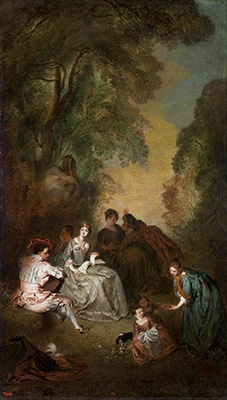 |
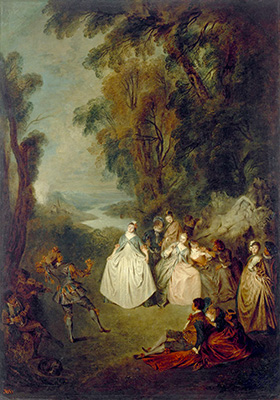 |
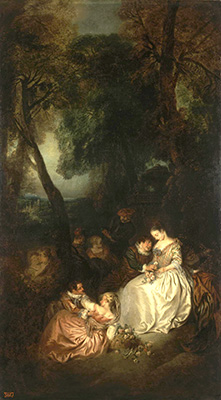 |
St. Petersburg, Hermitage Museum, inv. nos. ГЭ 7524, 5623, 7525.
Oil on canvas
The Concert (left): 149 x 84 cm; The Dance (center): 147.5 x 101.5 cm; Romance (right): 149 x 84 cm.
ALTERNATIVE TITLES
Les Agréments de l’été
L’Amour à la campagne
Le Divertissement musicale
Scene in a Park
PROVENANCE
St. Petersburg, collection of Catherine II (1729-1796; Empress of Russia); given to her lover, Count Grigori Orlov
St. Petersburg, collection of Count Grigori Orlov (1734-1783). Housed in the Marble Palace.
Moscow, Pushkin Museum of Fine Arts,1921-1934.
Transferred to the Hermitage Museum in 1934.
EXHIBITIONS
Petrograd, Hermitage, First Hermitage Exhibition (1920), 16.
Petrograd, Hermitage, Peinture française des XVIIe et XVIIIe siècles (1922).
Leningrad, Hermitage, Watteau and His Time (1972), cat. 44-45.
SELECT BIBLIOGRAPHY
Benois, History of Painting (1912), 4: 280.
Miller, “French Paintings” (1923), 59-60
Miller, “Ein Spätwerk Watteaus” (1926/27), 255-64.
Ernst, “L’Exposition de peinture française” (1928), 170-72
Ingersoll-Smouse, Pater (1928), cat. 33 bis, 71 ter, 234 bis.
Réau, “Watteau” (1928), cat. 203-05.
Réau, L’Art français dans les musées russes (1929), cat. 268, 610-11.
Nemilova, La Peinture française du XVIIIe siècle (1982), cat. 255-57.
Nemilova, French Painting Eighteenth Century (1986), cat. 176-78
Vogtherr, Französische Gemälde (2011), 272.
Wine, Eighteenth Century French Paintings (2018), 362.
REMARKS
It can be presumed that when these paintings were still in Paris in the early eighteenth century they were attributed to Pater. But in the later part of that century, either in Paris or St. Petersburg, their attribution must have been upgraded to Watteau, a move frequently encountered in the marketplace. The new attribution to Watteau remained in place throughout the nineteenth century and well into the early twentieth. It was retained by Benois, Miller, Ernst, and Réau. The pictures were also presented at several exhibitions under Watteau’s name in the first half of the twentieth century. The situation changed in the 1920s, first when Ingersoll-Smouse included them in her monograph on Pater, and then when Réau changed his earlier opinion and listed The Dance under Pater’s name. At this point, the attribution to Watteau fell from favor. Adhémar did not include the three paintings in her catalogue of Watteau’s works nor did later critics. Likewise, at first the Hermitage questioned the attribution to Watteau and now correctly endorses the attribution to Pater.
Indeed, the attribution to Pater is sustained not only by the paintings’ style but also by the strong analogies among these compositions and other pictures by Pater.
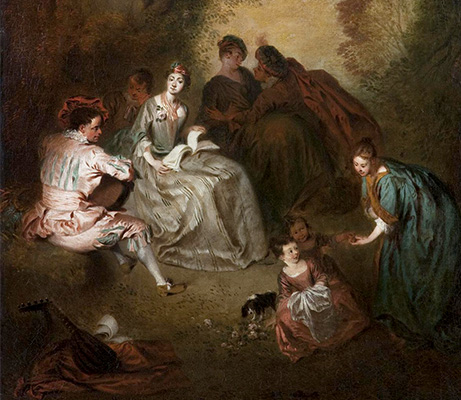
Jean-Baptiste Pater, Scenes in a Garden, The Concert (detail).
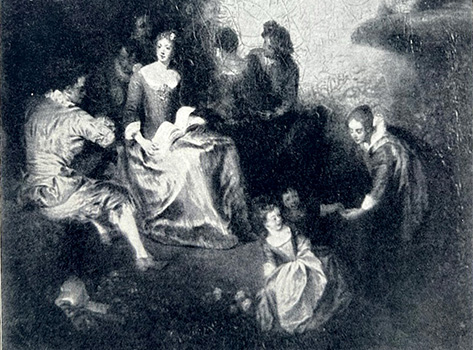
Jean-Baptiste Pater, Les Agréments de l’été (detail), formerly in the collection of the Duke of Sutherland.
All the figures in The Concert—the musician at the left, the woman with an open parts book in her lap, the two children and their governess at the right, even the amorous couple in the background—find counterparts in Pater’s Les Agréments de l’été, a painting formerly in the collection of the Duke of Sutherland. Confusing issues further, the ex-Sutherland picture was also misattributed to Watteau.
Likewise, many of the characters in The Dance have counterparts in paintings by Pater. Its concordance with The Dance in the National Gallery, London, is noteworthy. The male dancer at the left, his partner gracefully extending her skirt, the seated woman with her fan to her face and the woman reclining against her, the man seated on the ground watching the festivities—these many figures and in the same order are shared by both paintings. In addition, similar groupings are found in other Pater paintings, such as those in museums in Berlin and Worcester, Massachusetts. The sculpture of the sleeping nymph in the Hermitage painting, her arm extended back over her head, is the sister to a number of similarly posed sculptures in Pater’s fêtes galantes as well as in his Jupiter and Antiope (a picture sometimes misattributed to Watteau).
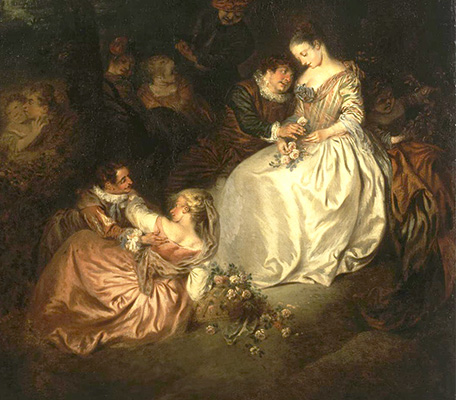
Jean-Baptiste Pater, Scenes in a Garden, Romance (detail).
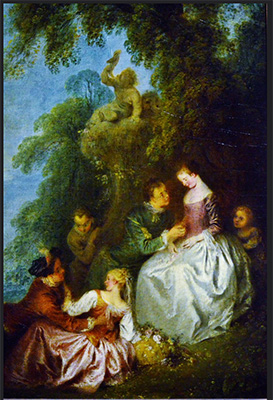
Jean-Baptiste Pater, Scene champêtre. Whereabouts unknown.
Similarly, the amorous couples in the foreground of the third panel in the Hermitage have counterparts in established paintings by Pater, such as a picture of similarly minded couples whose present whereabouts is unknown. The couple at the left in the St. Petersburg painting is more physical but the overall spirit remains much the same.
The attribution of the three St. Petersburg paintings to Pater seems a reasonable resolution of the issue. Much overpainting obscures the original surface but the portions that are visible offer hope. Vogtherr’s demotion of the pictures to just “the circle of Pater” is perhaps too severe.
This ensemble of three compositions is unusual in several ways. While Watteau and his followers painted
many pairs, there are no groupings of three picture. Also, the large scale of the trio of paintings is almost without parallel. Only a few works by Watteau, such as L’Enseigne de Gersaint and the Gilles in the Louvre, are as large or still larger, but these examples served special purposes such as signboards, the former for Gersaint’s art gallery and the latter presumably for a theater or café. By contrast, the function of the trio of paintings in the Hermitage is uncertain. It would seem that they were intended to ornament a salon or similar domestic space, not as individual units, but as a triptych on one wall or possibly on different walls. The compositions of the trio of paintings suggests that The Dance with its symmetric design was the central picture whereas The Concert is balanced to the left while Romance is weighted to the right, thus establishing their flanking roles. While the two outer pictures are identical in height, The Dance at center is slightly shorter, suggesting that they were designed for a specific site that required such an adjustment.
As singular as Pater’s canvases might be, there is evidence for other such large-scale decorative works in the early eighteenth century as, for example, a pair of pictures by Jean Raoux that were executed in 1728. What a stunning effect these large fêtes galantes would have achieved in their original settings.
